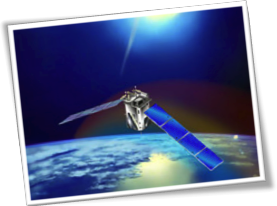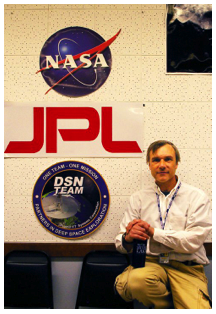
Professional Development – Chemistry of Water: Mars Exploration — Is There Water on Mars?
May 14, 6:30 p.m. EDT
Learn to use an inquiry-based lesson about how atmospheric pressure and vapor pressure affect the boiling point of water. See why water’s boiling point is pressure-dependent, rather than temperature-dependent. Then, by extension, you will deduce if there could be liquid water on Mars.
![]()
Live Video Chat – Astronaut Greg Johnson — Living and Working in Space
May 15, noon – 1 p.m. EDT
Opportunity for students in grades 4-12 to ask astronaut Greg Johnson questions during a live video chat about his education, astronaut training and experiences while living and working in space.

Professional Development – Engineering Design Challenge: Thermal Protection System
May 15, 8:15 p.m. EDT
Learn about the science of heat transfer and heat dissipation related to NASA vehicles, and receive an introduction to the associated engineering design challenge, Thermal Protection System.

NASA Now – Microgravity ResearchMay 16Nancy Hall, a research scientist at NASA Glenn Research Center, discusses different ways matter acts in the gravity on Earth and in microgravity and how she uses a drop tower for testing.

Professional Development – Linear Regression: Exploring Space Through Math – Space Shuttle AscentMay 16, 8 p.m. EDTDiscover how you can use the Space Shuttle Ascent activity to construct a knowledge bridge for your students between the algebra concepts they learn in your classroom and space exploration.
![]()
Live Video Chat– R2 Technology Lends a Helping HandMay 18, 1 – 2 p.m. EDTC.J. Kanelakos, a mechanical design engineer on the Robonaut 2 project will answer student questions about Robonaut 2, or R2. Join the video chat for an opportunity to ask CJ about her career path, how she became interested in technology and any questions you may have about engineering at NASA!Link to the NES Virtual Campus home page.
Link to the NES Virtual Campus home page.

 NASA’s Spitzer Space Telescope has detected light emanating from a “super-Earth” beyond our solar system for the first time. While the planet is not habitable, the detection is a historic step toward the eventual search for signs of life on other planets.
NASA’s Spitzer Space Telescope has detected light emanating from a “super-Earth” beyond our solar system for the first time. While the planet is not habitable, the detection is a historic step toward the eventual search for signs of life on other planets. In this episode of NASA Now, Nicholas Johnson, chief scientist for the Orbital Debris Office, talks about “space junk” and the task of his office in tracking all of the orbiting debris. NASA is the international lead in conducting measurements of the space environment and in developing the technical consensus for adopting measures to protect users of the orbital environment.
In this episode of NASA Now, Nicholas Johnson, chief scientist for the Orbital Debris Office, talks about “space junk” and the task of his office in tracking all of the orbiting debris. NASA is the international lead in conducting measurements of the space environment and in developing the technical consensus for adopting measures to protect users of the orbital environment.
 NASA’s 747 Shuttle Carrier Aircraft with Enterprise mounted atop flew at a relatively low altitude over various parts of the New York City metropolitan area near a variety of landmarks, including the Statue of Liberty and Intrepid. After the flyover it landed at JFK International Airport.The Federal Aviation Administration coordinated the flight.
NASA’s 747 Shuttle Carrier Aircraft with Enterprise mounted atop flew at a relatively low altitude over various parts of the New York City metropolitan area near a variety of landmarks, including the Statue of Liberty and Intrepid. After the flyover it landed at JFK International Airport.The Federal Aviation Administration coordinated the flight. Meet Fernando Zumbado, a NASA Robotic Systems Engineer who works with the Multi-Mission Space Exploration Vehicle, or MMSEV. Zumbado explains how the robotic MMSEV vehicle is designed to adapt to its environment, capable of both in-flight missions and surface exploration of microgravity bodies.
Meet Fernando Zumbado, a NASA Robotic Systems Engineer who works with the Multi-Mission Space Exploration Vehicle, or MMSEV. Zumbado explains how the robotic MMSEV vehicle is designed to adapt to its environment, capable of both in-flight missions and surface exploration of microgravity bodies. A key NASA instrument that can directly measure the impact of solar events on Earth’s upper atmosphere has “weighed in” on the huge flare that impacted Earth recently.
A key NASA instrument that can directly measure the impact of solar events on Earth’s upper atmosphere has “weighed in” on the huge flare that impacted Earth recently. NASA Explorer Schools teacher Vin Urbanowski wanted to plan something exciting for a substitute teacher to use. He decided to use the NASA Explorer Schools featured lesson, Linear Regression: Exploring Space Through Math — Space Shuttle Ascent. Urbanowski planned this as an independent project and instructed students to create computer presentations for him to review when he returned to class the following day. This seemed to be a good way to ensure that students did the work.
NASA Explorer Schools teacher Vin Urbanowski wanted to plan something exciting for a substitute teacher to use. He decided to use the NASA Explorer Schools featured lesson, Linear Regression: Exploring Space Through Math — Space Shuttle Ascent. Urbanowski planned this as an independent project and instructed students to create computer presentations for him to review when he returned to class the following day. This seemed to be a good way to ensure that students did the work.